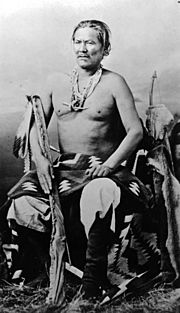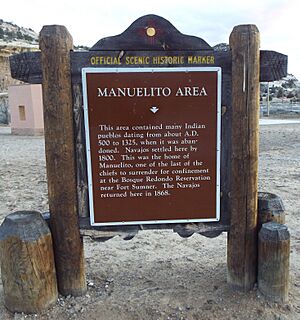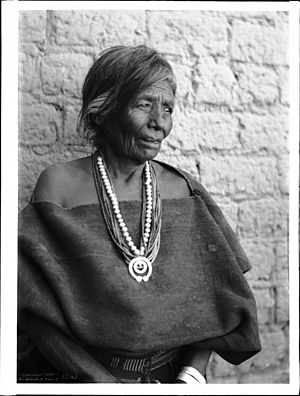Manuelito facts for kids
Quick facts for kids
Manuelito
|
|
|---|---|
| Hastiin Chʼil Haajiní | |

Who is Chief Manuelito? '
|
|
| Navajo leader | |
| Personal details | |
| Born | c. 1818 Bears Ears, Southeastern Utah |
| Died | 1893 (aged 74–75) Manuelito Springs, New Mexico |
| Cause of death | Measles; pneumonia |
| Spouses | Asdzáá Tl'ógí, ("Weaver Woman") |
| Known for | Resisting the Long Walk of the Navajo and a Navajo War leader |
| Nickname | Ashkii Diyinii |
| Military service | |
| Battles/wars | Americans and New Mexico Raiders/Mexicans, Apache Wars |
Chief Manuelito (1818–1893) was a brave and important leader of the Diné people, also known as the Navajo. His Navajo name was Hastiin Chʼil Haajiní, which means "Man of the Black Plants Place." He was also called Ashkii Diyinii ("Holy Boy") by his people.
Manuelito is famous for leading his people against the United States military. For many years, he fought against efforts to force the Navajo people to move to Bosque Redondo, New Mexico. This forced journey is known as the Long Walk in 1864.
After being moved to Bosque Redondo, Manuelito was one of the leaders who signed a special agreement in 1868. This agreement, called the Treaty of Bosque Redondo, ended their time in government camps. It also created a reservation for the Navajo people. Manuelito believed in education for Navajo children. He famously said, "My grandchildren, education is a ladder. Tell our people to take it."
Contents
Manuelito's Early Life
Manuelito was born around 1818 near the Bears Ears in southeastern Utah. He belonged to the Bit'ahnii Clan.
He married Juanita, who was the daughter of a powerful leader named Narbona. Manuelito joined Narbona's group and lived near the Chuska Mountains. He looked up to Narbona's strength and courage.
As a young man, Manuelito was very athletic. He was skilled with arrows and always won foot races and wrestling matches. He was eager for his first battle. In 1835, when he was about 17, he fought against Mexican forces from New Mexico. In this battle, he earned the name Hashkeh Naabaah, meaning "Angry Warrior."
Over the years, Manuelito led many groups of warriors. He joined other leaders like Ganado Mucho and Barboncito. They fought against Mexicans, Hopis, Puebloan peoples, Utes, Comanches, and Apaches. They often sought food, livestock, and captives. Manuelito later married Juanita (1845–1910), who was a Mexican captive.
Juanita's Navajo name was Asdzáá Tl'ógí, which means "Weaver Woman." She was a skilled weaver. A dress and saddle blanket she wove are still preserved today.
Important Events Before the Long Walk
- 1835: Battle of Washington Pass
- Manuelito fought in this battle alongside Narbona. They defeated a large raiding group. Manuelito was 17 and earned the name "Angry Warrior."
- 1846: Treaty Signatory
- He was one of the leaders who signed the Lava Springs Treaty on November 22, 1846.
- 1849: Narbona's Death
- Manuelito was present when his father-in-law, Chief Narbona, was killed during a meeting with Colonel John M. Washington in the Chuska Mountains.
- 1853: Becoming a Speaker
- Chief Sarcillos Largos stepped down, and Manuelito was chosen to speak for the Navajo people. This happened when a treaty was being considered to separate Navajo and Mexican/American grazing lands.
- 1855: Official Chief
- Manuelito and Zarcillos Largos signed the Meriwether Treaty with the Americans. Manuelito was recognized as an "official chief" and received a peace medal.
- 1858: Land Disputes
- Manuelito told Major Brooks at Fort Defiance that the Navajo needed the pastures around the fort for their animals. His group moved their livestock closer, leading to a fight where Manuelito lost many animals.
- 1860: Successful Ambush
- Manuelito and Sarcillos Largos set a successful ambush against Mexican/American raiders at Whiskey Lake. Forty of the raiders died.
- 1864: Start of the Long Walk
- This year marked the beginning of the Long Walk period. Manuelito's group was still in their homeland, Dinetah.
- 1865-1866: Resistance and Surrender
- The U.S. Army sent messengers to tell Manuelito to come in. Utes also attacked Manuelito's camp. In September 1866, Manuelito and his group finally came to Fort Wingate and then went to Bosque Redondo.
- 1867: Raids and Return
- Manuelito left Bosque Redondo to raid Utes after Comanches and Utes attacked the Navajo there. He and his group later returned.
- 1868: Treaty of Bosque Redondo
- Manuelito was one of the important leaders who signed the Treaty of Bosque Redondo. This treaty officially ended the Long Walk and established the Navajo reservation.
Manuelito's Life After the Long Walk
After returning to their homeland, Manuelito lived east of Tohatchi. He became the main chief for the eastern Navajo people.
- 1871: Head Chief
- Manuelito was named the Head Chief of the Navajo Tribe after Barboncito passed away.
- 1872: Police Force Leader
- He was appointed to lead the new Navajo police force.
- 1876: Meeting President Grant
- Manuelito spoke with President Grant about land issues. White settlers were moving onto lands that belonged to the Navajo.
- 1879: Crop Failures
- When crops failed, some Navajo raided citizens and Zunis for food. Manuelito and Ganado Mucho arrested 40 men accused of stealing or witchcraft.
- 1880: Meeting President Hayes
- Manuelito met President Hayes in Santa Fe. He also suggested he become "Chief of Scouts" to help control illegal whiskey sales on the reservation.
- 1882: Education for His Sons
- Manuelito sent his two sons to the Carlisle Indian Industrial School to get a Western education. He also asked for water pipes and received permission to hunt off the reservation with 20 men.
- 1883: Sadness and Leadership
- Manuelito's two sons became sick at the Carlisle school. One son died there, and the other died soon after returning home. An agent reported that about 4,000 Navajo people followed Manuelito in the eastern reservation area.
- 1884: New Head Chief
- Henry Chee Dodge took over as the Head Chief of the Navajo Tribe.
- 1893: Manuelito's Death
- Manuelito passed away from measles, which was made worse by pneumonia.
- 1980: Honoring Manuelito
- The Navajo Nation created a scholarship in Manuelito's honor. It is the most important scholarship the Navajo Nation offers for college education.
See also
 In Spanish: Manuelito para niños
In Spanish: Manuelito para niños



